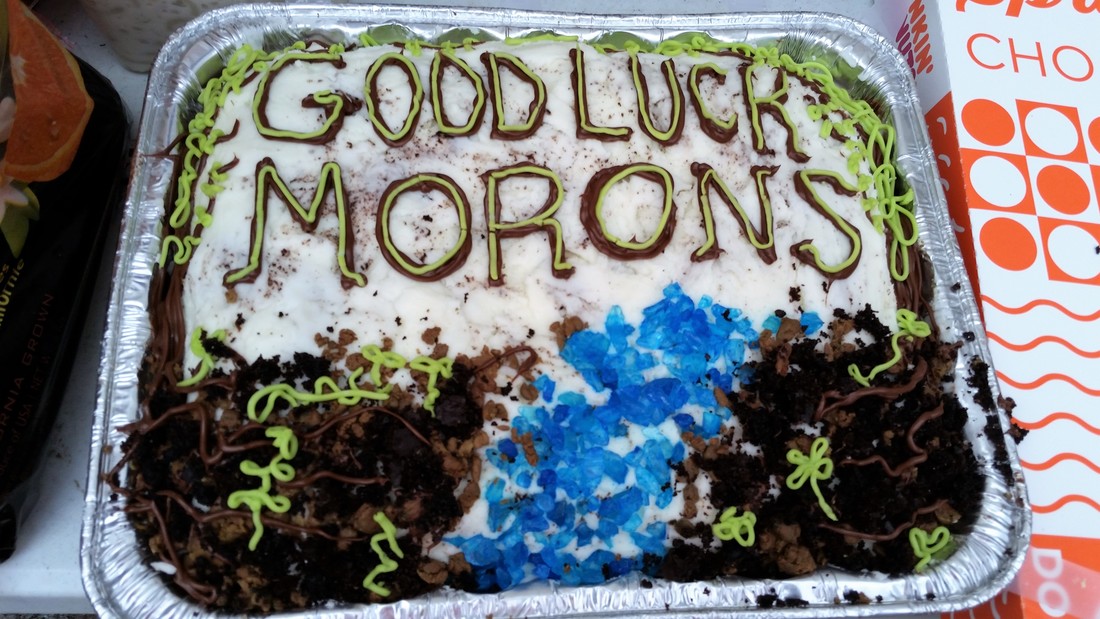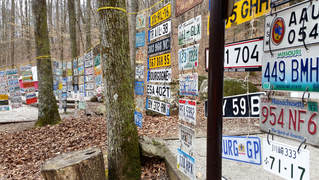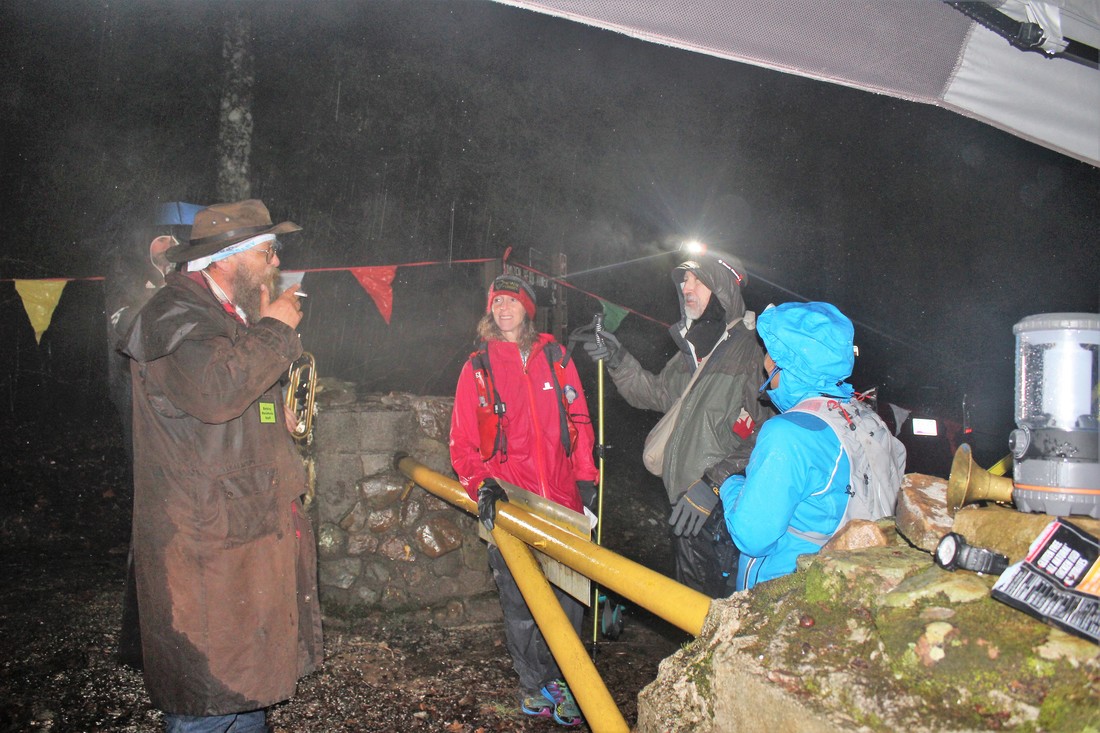|
Stories from “Out There” – The Barkley Marathon I was only about an hour into the 2018 Barkley Marathon, standing on top of the Pillars of Death, when I looked down and noticed my map was gone. Just freaking gone! My gut dropped. I looked around, feeling queasy. The two veterans I was keeping in sight had moved on. I hopped back and forth, scanning the area, only to conclude that my map was somewhere in the depths of the stone columns on which I stood. I considered climbing down the Pillars of Death in hopes of retrieving the hand-drawn map that I’d copied from the race’s master map the night before. I’d made two copies but was only carrying one on me. Dumbass! Time to take a breath, calm down, think…and pray.  The How It was March 2015 when my curiosity about the Barkley Marathon first took hold. I sat there in a van full of runners on my way to Urique, Chihuahua, Mexico to run Caballo Blanco, listening to Don Winkley talk about the legendry race and Lazarus Lake, the mad scientist behind it. Don told us how Barkley was “the world’s toughest foot race” and how bad things happened when you were “out there” Up until that point, I was aware of Barkley but had never met anyone who had run it. And I’d never considered running it myself. But, really, how insane could a race really be? Upon returning to the U.S., I began to the scratch the inevitable itch. How did you even enter the race? It was like piecing together a puzzle; no one ever gives you all the information. As I researched and read and learned more about the Barkley “cult,” there was this underlying sense of exhilaration — and fear — that set my heart racing. I researched more, learned more, networked more. I was finally able to learn how to apply, and later in 2015 I submitted my entry. (No, I’m not telling you when or how.) Those lucky enough to get into the race receive a condolence letter rather than a congratulation letter. I didn’t get one, but I landed on the “weight list,” which meant that Lazarus had seen something he liked in my application. Or maybe he was lining me up to be a future “human sacrifice,” the person who has “no business” running Barkley but whose certain failure provides comic relief. As I followed the slow progress of the weight list, it became apparent I wouldn’t be running Barkley in 2016. Fast forward to sometime later in 2016, and in my second year of applying I moved up the weight list. In fact, I was number 10! Panic set in as I realized I had a very high probability of making it into the 2017 edition of Barkley. I started training. Admission of stupidity: Up until this point I’d never held a map and compass in my hand, even though navigation is central to traveling the course at Barkley. I reached out to Al Beers, who at the time was vice-president of the St. Louis Orienteering Club. We’re fortunate to have a permanent orienteering course in St. Louis, so once a week I met Al and he helped me learn the ropes. I wasn’t very good at first, but I kept at it because, well, what choice did I have? I made it up to number three on the weight list for the 2017 Barkley Marathon, but once more received no condolence letter. So, I did what any stubborn and spurned ultra runner does and applied again. I patiently waited until, one afternoon while out running errands, my phone pinged to notify me of a new email message. I opened my inbox folder, and my heart skipped a beat. There it was: the much-awaited and dreaded condolence letter. I was in the 2018 Barkley Marathon! I was ecstatic!  Training As the realization of what I would be up against set in, a questioned emerged: How the hell was I going to train for the menacing elevation of Barkley? The steepest climb near where I live is no more than 340 feet per mile! I was at a major disadvantage and almost certainly lining myself up for failure, but lack of vertical was no excuse for not going out there and trying. Sometimes trying is all you can do, and I had to try. In short, my training plan consisted of registering 50-mile weeks with 10,000+ feet of vertical. I bushwhacked, a lot, mainly to get accustomed to running and hiking off trail. I figured that instead of pushing my mileage I’d condense my weekly average vertical, hoping this would keep me upright for a loop or two at Barkley. I also, reached out to Jeff Ryan, a board member of the St. Louis Orienteering Club, to help me brush up on my navigation skills. (Al had since moved away.) After a few rustic rounds of navigation with Jeff, I decided the only way I was going to learn was to do it alone. So, a few times a week I’d head out to the orienteering course, working on reading the map features and shooting bearings — and in the process getting lost and finding my own way out. By the end of my taper week, I’d gone from “where the hell am I?” to being able to pinpoint exactly where I was on the map and where I needed to go. I was comfortable getting lost in the woods, yet I questioned my ability to navigate at Barkley’s Frozen Head State Park.  Failure to Launch So, there I was at the Pillars of Death with no map. Was my race over even before it had started? Think…and pray. After a series of arguments with myself, I decided to wait for the next runner to come up behind me, hoping I could hang with them and try to knock out at least one loop. Just then, Amy Winters came around the bend. After a brief introduction and explanation of what had happened, we decided to work together. I would need to run at Amy’s pace, which I was fine with as long as we got through the first loop within the cutoff time of 13 hours, 20 minutes. Except it was going to be slow; Amy had a prosthetic leg and had been invited to Barkley because Lazarus wanted to see “if a girl with one leg could finish a loop.” I was instantly in awe of Amy. She moved exceptionally well on the ascents, much better than I did on two legs. It was truly admirable to watch. With me navigating and Amy keeping a steady pace, we made it to the first of the 13 books from which we would need to retrieve the page that corresponded to our bib number. All was not lost! Not long after that, another female runner, Melody Hazi, who had blown past book 1, caught up to us from behind, and the three of us navigated to book 2. At this point we were about three or four hours into the race, and Amy had already run out of drinking water. She didn’t want to fill up from the nearby creek because the filter she was carrying didn’t fit her bottles; we would hit the first water drop after book 4, though, so we went on. I offered to share my water, since I had a 2.5-liter bladder and another 20-ounce flask. Amy said she’d ask for it when she needed it. We grabbed our pages from book 2 and continued with Melody in the lead. We “scurried” up the high wall instead of going around it to save some time. Somewhere between book 2 and book 3, about five hours into the race, Amy announced she had exhausted her food supplies. I had a moment of panic but then realized I’d packed enough food to last me for 24 hours, and from there on out, I shared my food with Amy. This was also the moment I looked up to see that Melody was moving out of sight. I considered dropping Amy and continuing forward with Melody, but she was already ascending the crest of the hilltop. No big deal, I figured. If we ran into Melody or another runner later on, I could split with them. Does that sound cutthroat? Perhaps. But that’s the Barkley Marathon. It’s an every-person-for-themselves, last-person-standing kind of race. You need to be self-sufficient. There’s no margin for error; any small mistake can lead to a major catastrophe. This might mean you have to be ruthless and selfish in your decisions. If you’re working together to get from one book to another, and the thread breaks because you’re the weak link, then you get left behind. This coming from a person who had lost her map just an hour in! Anyhow, on our way to book 3, I overshot my bearing and, as we ran the trail and started to descend one of the switchbacks, I realized my mistake. Book 3 was on top of Bald Knob, so we backtracked and started the assent. We made our way to the hilltop and got our pages. I looked over the edge just as we were engulfed by a thick cloud of fog and a light, steady drizzle commenced. It was earie, and visibility was shot. Was it still daylight? It was hard to tell. As we made our way back to the trail, Amy mentioned she was worried about carrying on in the thick fog and the dark hours of the night that lay ahead because she did not have a headlamp. I didn’t know how to react to this…. How does someone attempting the Barkley Marathon forget to pack a headlamp?!?!?! Just how? In that instant, my fate was sealed. Time was ticking away, and with each passing hour, daylight faded. The rain became a thunderstorm, only getting worse as darkness descended (except for the occasional stab of lightening). I tried to stay positive and continue forward. We just needed to get through a loop, I kept telling myself, even if we were over the time limit. I had to empathize with Amy, because, whom am I kidding, I was the dumbass who had lost her map. Still, it was difficult to comprehend having not packed enough water or food — or a headlamp! — on what is considered one of the toughest 100-mile races in the world. I’d packed two headlamps with three sets of backup batteries, so doing the math I figured we could keep moving forward in the dark, but I wasn’t sure if my food supplies were enough for the both of us.  Following the park boundary on the “candy ass” trail, we made it to Garden Spot, took our pages from book 4, and put on our rain jackets and extra layers of clothing. Temperatures were dropping steadily, and showers were coming down with no sign of stopping. Every footfall felt like stepping in slop. In a rush, we blew past the water drop and ended up at a T on a Jeep road. I stopped, trying to figure out which direction we had to go, when Thomas Armbruster appeared out of nowhere. He had been going up and down the road in both directions for the past two hours, unable to find his way to book 5. He’d finally decided to throw in the towel and was headed back to camp on Quitter’s Road, where it would take him another three hours to reach the start/finish line at the yellow gate. Not even quitting Barkley is easy. Self-extraction is mandatory, and if you dare to go out there, then you better be able to get your arse back. Help is not coming. After a brief chat with Thomas, we decided to continue to book 5 in the same direction that Melody had taken. I wasn’t sure if we were headed in the right direction, as none of this was on the map — no Jeep road, just directions that were hard to follow. I couldn’t shoot a bearing and follow that because we’d technically be cutting course. Wandering for an hour in the downpour, Amy and I were nowhere close to any of the landmarks mentioned in the course directions. It was getting dark, and I handed my spare headlamp to Amy. I stood staring down at the map, trying to find any recognizable landmark. I was completely drenched and hypothermic, my hands shaking and rain pouring off the bill of my jacket hood like it was an awning. I told Amy we needed to backtrack to a point where I knew where we were on the map, then shoot a bearing for Stallion Mountain. Amy didn’t want to go back and asked if I could take a bearing and continue on. Shooting a random bearing would be futile and dangerous since we had no idea where exactly we were and I was hypothermic. We hiked back up the Jeep road, and after getting a better handle on our location, it was mutually agreed that we needed to head back to the yellow gate. I shot a bearing straight for Panther Gap Trailhead, and we took the trail back out to the parking lot. On our way back to the yellow gate we picked up Leonard Martin, who had turned around after book 8, unable to ascend the epic climb at Rat Jaw due to poor footing, torrential downpour and no visibility. As the three of us hiked back to the start/finish to face our demise, I was shivering and couldn’t think straight. Back at the yellow gate, we each earned a round of taps on the bugle, as all quitters do. I gave Amy a hug for our time shared together and made a B-line for the car to dry off and get some food to eat. And, just like that, my Barkley Marathon experience was over. Conclusion I have a lot of mixed emotions about what happened out there. Sigh! To say I’m disappointed in myself would be an extreme understatement. I’d like to think that sticking with Amy was the right thing to do, but there’s another part of me that wonders what would’ve happened if I’d stuck with another runner instead. What if? I sit here second-guessing the choices I made that resulted in my failure, my inability to finish a loop. The question is not how but whether I’m ready to deal with the aftermath. Barkley is unlike anything I’ve ever done, and I doubt anything will ever come close to my experience of being “out there.” I went into the race unsure of my orienteering skills but came back feeling confident in my ability to navigate. I know that I need to move on with rest of my racing season but somehow can’t. Anyone who has run Barkley knows how the race gets in your blood and poisons you for good. Everyone who passes the yellow gate on race day makes their own reality while out there. I hope I’ll be invited back to Frozen Head in the future, so at least I’m able to complete a loop. When I’m 70 years old, sitting on my front porch, smoking my pipe, I want to be able to look back and say, “I was really, truly ‘out there.’” To my crew Brad Kovach and Tim Garvey: Thank you! Your support was invaluable, and I will always be in debt to you guys for being “out there” for me. Ode to “Out There” Out there it’s beautiful Out there is where it’s wild and untamed Out there is where time gets fast but everything else gets slow Out there you create your own reality Out there is where dreams go to die Out there help is not coming Yet “Out There” is where I long to be. Gear List
Shoes – Women’s Altra Timp Rain Jacket – Showers Pass Women’s Refuge Waterproof Jacket Shirt – 32 Degree Long Sleeves Base Layer Jacket – Pearl Izumi Women’s Fly Softshell Run Hoody Pants – Showers Pass Women’s Track Pants Socks – Fits Medium Hiker Crew Gloves – HEAD Sensatec Running Gloves Trekking Poles – Black Diamond Distance Z Trekking Poles Hydration Pack – Osprey Women’s Dyna 15 Hydration Pack Headlamps – Petzl Nao Performance Headlamp and Black Diamond Icon Headlamp |
AuthorsOur blog writers are members of Terrain Trail Runners, local athletes just like you, who want to share their love and knowledge of the sport. Archives
March 2023
Categories
All
|



























 RSS Feed
RSS Feed